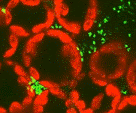Plant Pathology, Department of

Department of Plant Pathology: Faculty Publications
Document Type
Article
Date of this Version
2012
Citation
Plant Health Progress doi:10.1094/PHP-2012-0723-04-RS
Abstract
To better understand the fine-scale spatial dynamics of brown rot disease and corresponding fungal genotypes, we analyzed three-dimensional spatial patterns of pre-harvest fruit rot caused by Monilinia fructicola in individual peach tree canopies and developed microsatellite markers for canopy-level population genetics analyses. Using a magnetic digitizer, high-resolution maps of fruit rot development in five representative trees were generated, and M. fructicola was isolated from each affected fruit. To characterize disease aggregation, nearest-neighbor distances among symptomatic fruit were calculated and compared with appropriate random simulations. Within-canopy disease aggregation correlated negatively with the number of diseased fruit per tree (r = −0.827, P = 0.0009), i.e., aggregation was greatest when the number of diseased fruit was lowest. Sixteen microsatellite primers consistently amplified polymorphic regions in a geographically diverse test population of 47 M. fructicola isolates. None of the test isolates produced identical multilocus genotypes, and the number of alleles per locus ranged from 2 to 16. We are applying these markers to determine fine-scale population structure of the pathogen within and among canopies.


Comments
Copyright © 2012 Plant Management Network